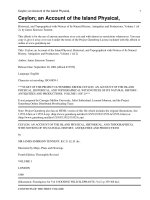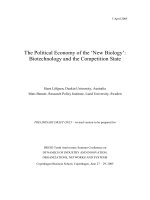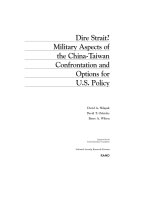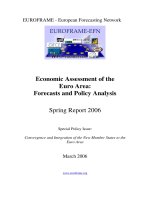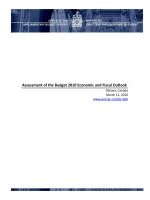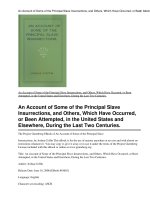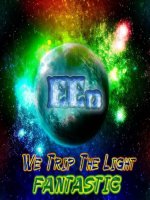visions of the future chemist ry and life science
Bạn đang xem bản rút gọn của tài liệu. Xem và tải ngay bản đầy đủ của tài liệu tại đây (2.27 MB, 209 trang )
Visions of the Future: Chemistry and Life Science
Leading young scientists, m any holding prestigious Royal Society
Research Fellowships, describe their research and give their visions of the
future. The articles, which have been re-written in a popular and well-
illustrated style, are derived from scholarly and authoritative papers pub-
lished in a special Millennium Issue of the Royal Society’s Philosophical
Transactions (used by N ewton; this is the world’s longest-running scien-
tific journal). The topics, which were carefully selected by the journal’s
editor, Professor J. M. T. Thompson FRS, include studies of atoms and m ol-
ecules in m otion; new processes and m aterials; nature’s secrets of biologi-
cal growth and form ; progress in understanding the hum an body and m ind.
The book conveys the excitem ent and enthusiasm of the young authors for
their work in chem istry and life science. Two com panion books cover
astronom y and earth science, and physics and electronics. All are defini-
tive reviews for anyone with a general interest in the future directions of
science.
M ic h ael T h ompso n is currently Editor of the Royal Society’s
Philosophical Transactions (Series A). He graduated from Cambridge with
first class honours in Mechanical Sciences in 1958, and obtained his PhD
in 1962 and his ScD in 1977. He was a Fulbright researcher in aeronautics
at Stanford University, and joined University College London (UCL) in
1964. He has published four books on instabilities, bifurcations, catastro-
phe theory and chaos, and was appointed professor at UCL in 1977.
Michael Thom pson was elected FRS in 1985 and was awarded the Ewing
Medal of the Institution of Civil Engineers. He was a senior SERC fellow
and served on the IMA Council. In 1991 he was appointed director of the
Centre for N onlinear Dynamics.
Visions of the Future:
Chemistry and
Life Science
Edited by J. M. T. Thompson
pu bl ish ed by t h e pr ess syn d icat e o f t he u n iver sit y o f c ambr idg e
The Pitt Building, Trum pington Street, Cambridge, United Kingdom
c a mbr idg e u niver sit y pr ess
The Edinburgh Building, Cambridge CB2 2RU, UK
40 West 20th Street, N ew York, N Y 10011-4211, USA
10 Stam ford Road, Oakleigh, VIC 3166, Australia
Ruiz de Alarcón 13, 28014 Madrid, Spain
Dock House, The Waterfront, Cape Town 8001, South Africa
bridge.org
© The Royal Society 2001
This book is in copyright. Subject to statutory exception
and to the provisions of relevant collective licensing agreem ents,
no reproduction of any part m ay take place without
the written permission of Cam bridge University Press.
First published 2001
Printed in the United Kingdom at the University Press, Cambridge
Typeface Trum p Mediaeval 9/13 pt. System QuarkXPress™ [se]
A catalogue record for this book is available from the British Library
Library of Congress Cataloguing in Publication data
Visions of the future : chemistry and life science / edited by J. M. T. Thom pson
p. cm
Includes index.
ISBN 0 521 80539 2 (pb.)
1. Chemistry. 2. Life sciences. I. Thom pson, J. M. T.
QD39.V53 2001
540–dc21 00-053007
ISBN 0 521 80539 2 paperback
Contents
Preface by J. M. T. Thom pson page vii
Atoms and molecules in motion
1 Laser snapshots of molecular motions 1
Gareth Roberts
12 Enzymology takes a quantum leap forward 21
Michael J. Sutcliffe and N igel S. Scrutton
New processes and materials
13 World champion chemists: people versus computers 43
Jonathan M. Goodman
14 Chemistry on the inside: green chemistry in mesoporous
materials 59
Duncan J. Macquarrie
15 Diamond thin films: a twenty-first century material 75
Paul W. May
Biological growth and form
16 The secret of Nature’s microscopic patterns 95
Alan R. Hem sley and Peter C. Griffiths
17 Skeletal structure: synthesis of mechanics and cell biology 113
Marjolein C. H. van der Meulen and Patrick J. Prendergast
v
1 Understanding the human body
8 The making of the virtual heart 127
Peter Kohl, Denis N oble, Raim ond L. Winslow and Peter Hunter
19 Exploring human organs with computers 151
Paul J. Kolston
Understanding the human mind
10 Reverse engineering the human mind 171
Vincent Walsh
Contributor biographies 183
Index 197
vi CONTENTS
Preface
Writing here in a popular and well illustrated style, leading young scien-
tists describe their research and give their visions of future developm ents.
The book conveys the excitem ent and enthusiasm of the young authors. It
offers definitive reviews for people with a general interest in the future
directions of science, ranging from researchers to scientifically m inded
school children.
All the contributions are popular presentations based on scholarly and
authoritative papers that the authors published in three special
Millennium Issues of the Royal Society’s Philosophical Transactions. This
has the prestige of being the world’s longest running scientific journal.
Founded in 1665, it has been publishing cutting-edge science for one third
of a m illennium . It was used by Isaac N ewton to launch his scientific
career in 1672 with his first paper ‘N ew Theory about Light and Colours’.
Under N ewton’s Presidency, from 1703 to his death in 1727, the reputation
of the Royal Society was firm ly established am ong the scholars of Europe,
and today it is the UK’s academ y of science. Many of the authors are
supported financially by the Society under its prestigious Research
Fellowships schem e.
Series A of the Philosophical Transactions is devoted to the whole of
physical science, and as its Editor I m ade a careful selection of m aterial to
cover subjects that are growing rapidly, and likely to be of long-term inter-
est and significance. Each contribution describes som e recent cutting-edge
research, as well as putting it in its wider context, and looking forward to
future developm ents. The collection gives a unique snapshot of the state
of physical science at the turn of the m illennium , while CVs and pho-
tographs of the authors give a personal perspective.
The three Millennium Issues of the journal have been distilled into
three corresponding books by Cambridge University Press. These cover
vii
astronom y and earth science (covering creation of the universe according
to the big bang theory, hum an exploration of the solar system , Earth’s deep
interior, global warming and climate change), physics and electronics (cov-
ering quantum and gravitational physics, electronics, advanced com puting
and telecom m unications), and chem istry and life science (covering the
topics described below).
Topics in the present book on chemistry and life science include
studies of atom s and m olecules in m otion, the developm ent of new
processes and m aterials, nature’s secrets of biological growth and form ,
physical techniques in biology, progress in understanding the hum an body
and m ind, and the com puter m odelling of the hum an heart.
J. M. T. Thompson
viii PREFACE
1
Laser snapshots of molecular motions
Gareth Roberts
Department of Chemistry, University of Cambridge, Lensfield Road,
Cambridge CB21EW, UK
1.1 Introduction
The molecular motions that drive the conversion of energy and matter in
physics, chemistry and biology take place over an amazingly rapid time,
measured in millionths of a billionth of a second (a femtosecond (fs)). On
time scales of this duration, atoms and molecules come together, exchange
energy and transfer atoms in the very act of transforming one material into
another. To map out such processes as they happen necessitates the appli-
cation of laser pulses with durations of tens, or at most hundreds, of fem-
toseconds to take ‘snapshots’ of the changes in real time.
This chapter discusses the application of femtosecond lasers to the
study of the dynamics of molecular motion, and attempts to portray how
a synergic combination of theory and experiment enables the interaction
of matter with extremely short bursts of light, and the ultrafast processes
that subsequently occur, to be understood in terms of fundamental
quantum theory. This is illustrated through consideration of a hierarchy of
laser-induced events in molecules in the gas phase and in clusters. A spec-
ulative conclusion forecasts developments in new laser techniques, high-
lighting how the exploitation of ever shorter laser pulses would permit the
study and possible manipulation of the nuclear and electronic dynamics in
molecules.
1
1.2 The interaction of intense femtosecond laser light with
molecules
The interaction of femtosecond laser light with atoms and molecules is
completely different to that involving longer laser pulses. This arises from
the ultrashort duration of femtosecond laser pulses, which is faster than
the characteristic dynamical time scales of atomic motion, and their ultra-
high intensity, which initiates a whole range of unprecedented phenom-
ena. What exactly happens when an intense, ultrafast laser beam irradiates
a sample of molecules depends crucially on the intensity of the laser,
which determines the number of photons supplied to an individual mole-
cule and can contort the allowed energy levels of the molecule; also impor-
tant is the frequency of the laser, which, together with the intensity,
affords optical access to different molecular energy states. The detailed
physics of the light–matter interaction will of course also depend on the
structure of the irradiated molecule, but whatever its identity, certain
general features of the excitation of atoms and molecules by ultrafast laser
photons have emerged from pioneering studies by research groups through-
out the world.
First to respond to the laser field are the lighter electrons, which do so
on a time scale of attoseconds (a thousandth of a femtosecond): depending
upon the intensity of the incident light, the one or more photons absorbed
by the molecule either promote an electron to a high-lying energy state of
the molecule, or the electron is removed from the molecule altogether,
leaving a positively charged ion; at very high intensities multiple electron
excitation and ionisation through various mechanisms can occur. Over a
far longer time scale of tens or hundreds of femtoseconds, the positions of
the atomic nuclei within the molecule rearrange to accommodate the new
electrostatic interactions suddenly generated as a result of the new elec-
tronic state occupancy prepared by the ultrafast laser pulse: the nuclear
motions may involve vibrations and rotations of the molecule, or the mole-
cule may fall apart if the nacent forces acting on the atoms are too great to
maintain the initial structural configuration. In addition, at high incident
intensities, the electric field associated with the laser beam distorts the
electrostatic forces that bind the electrons and nuclei in a molecule to such
an extent that the characteristic energy levels of the molecule are modified
during the ultrashort duration of the laser pulse.
Each of the above phenomena is the subject of intensive research pro-
2 G. ROBERTS
grammes in its own right. Figure 1.1 offers a simplified portrayal of some
of these events, showing the ionisation of an electron from the warped
potential energy structure an atom by an intense laser pulse, the path sub-
sequently followed by the electron in repsonse to the oscillating electric
field of the laser pulse, and the emission of a high-frequency harmonic
photon which occurs when the electron scatters off the ion core (high-har-
monic emission can be exploited to generate attosecond laser pulses, dis-
cussed in Section 1.4.1). A similar series of events, with due alteration of
the details, occurs in molecules exposed to intense laser light.
From careful measurements of such processs, it is possible to develop
quantitative models to describe the molecular dynamical response to
impulsive laser excitation. These enable the fundamental interaction of
intense, ultrafast laser light with molecules to be understood from first
Laser snapshots of molecular motions 3
Figure 1.1. A sequence of events following the interaction of an intense, ultrafast
laser pulse with an atom. The potential energy structure of the electron, which
would otherwise be symmetric either side of a minimum, thereby confining the
electron to the vicinty of the atomic nucleus, is distorted by the incident laser
radiation. The electron first escapes (ionises) from the atom by tunnelling through
the barrier on the side of lower potential energy and then executes an oscillatory
trajectory determined by its kinetic (or ponderomotive) energy in the electric field
of the laser pulse. If the electron follows a trajectory that brings it back close to
the nucleus of the ionised atom, emission of a high-frequency photon can occur as
the negatively charged electron is accelerated by the positively charged ion. This
high-frequency photon is found to be an exact harmonic (overtone) of the laser
frequency originally absorbed by the atom.
Tunnel ionisation
Laser-distorted
atomic electron
potential
Ponderomotive
electron trajectory
High harmonic
photon emission
principles in terms of the wave description of matter and light due to
quantum theory.
Following a description of femtosecond lasers, the remainder of this
chapter concentrates on the nuclear dynamics of molecules exposed to
ultrafast laser radiation rather than electronic effects, in order to try to
understand how molecules fragment and collide on a femtosecond time
scale. Of special interest in molecular physics are the critical, intermedi-
ate stages of the overall time evolution, where the rapidly changing forces
within ephemeral molecular configurations govern the flow of energy and
matter.
1.3 Femtosecond lasers
To carry out a spectroscopy, that is the structural and dynamical determi-
nation, of elementary processes in real time at a molecular level necessi-
tates the application of laser pulses with durations of tens, or at most
hundreds, of femtoseconds to resolve in time the molecular motions. Sub-
100fs laser pulses were realised for the first time from a colliding-pulse
mode-locked dye laser in the early 1980s at AT&T Bell Laboratories by
Shank and coworkers: by 1987 these researchers had succeeded in produc-
ing record-breaking pulses as short as 6fs by optical pulse compression of
the output of mode-locked dye laser. In the decade since 1987 there has
only been a slight improvement in the minimum possible pulse width, but
there have been truly major developments in the ease of generating and
characterising ultrashort laser pulses.
The major technical driving force behind this progress was the discov-
ery by Sibbett and coworkers in 1990 of a new category of ultrafast laser
operation in solid-state materials, the most important of which is sapphire
impregnated with titanium (others are the chromium-doped colquiriite
minerals). These devices rely upon the intensity dependence of the refrac-
tive index of the gain medium to generate powerful, ultrashort laser pulses
in a single ‘locked’ mode: a photograph of a commercial titanium:sapphire
laser is shown in Figure 1.2.
Titanium:sapphire lasers typically deliver pulses with durations
between 4.5 and 100 fs, and can achieve a peak power of some 0.8watts,
but this is not high enough to obtain adequate signal-to-noise ratio in
experiments where the number of molecules that absorb light is low. To
overcome this limitation, the peak power of a femtosecond laser can be dra-
4 G. ROBERTS
Figure 1.2. Photograph of a Tsunami titanium:sapphire laser manufactured by Spectra-Physics Lasers Inc.
(Mountain View, California). The lasing transition in Ti:sapphire is between vibrational levels of different
electronic states of the Ti
3ϩ
ion. Mode-locking of the laser is induced by an acousto-optic modulator,
which results in the propagation of pulses with high peak powers and femtosecond durations in a single,
‘locked’ mode, or standing wave pattern. The energy source required to drive a Ti:sapphire laser is
provided either by a diode or an argon-ion laser, both of which lase at the green wavelengths where Ti
3ϩ
is
strongly absorbing. When the population of the Ti
3ϩ
excited state exceeds that of the ground state, laser
radiation is emitted at red and near infrared wavelengths between 670 and 1070 nm.
matically increased by the process of chirped-pulse amplification. In this
technique, the weakly intense ultrafast pulses are first stretched in time to
between 100 and 1000 ps (a picosecond (ps) is 1000 fs), then amplified by
about a million times in one or more further Ti:sapphire laser crystals, and
finally recompressed to femtosecond durations. A typical peak power
achievable with an amplified Ti:sapphire laser today is a hundred billion
watts for a laser beam area of one square centimetre (the highest is just over
a thousand million billion watts per square centimetre), which contrasts
with an incident power of about 0.001watts received through the iris of a
human eye looking directly into the sun. For further details concerning the
physics which underpins the operation of ultrafast lasers and their amplifi-
cation, the interested reader is referred elsewhere for information (see
Further reading).
For studies in molecular physics, several characteristics of ultrafast
laser pulses are of crucial importance. A fundamental consequence of the
short duration of femtosecond laser pulses is that they are not truly mono-
chromatic. This is usually considered one of the defining characteristics of
laser radiation, but it is only true for laser radiation with pulse durations
of a nanosecond (0.000 000 001s, or a million femtoseconds) or longer.
Because the duration of a femtosecond pulse is so precisely known, the
time-energy uncertainty principle of quantum mechanics imposes an
inherent imprecision in its frequency, or colour. Femtosecond pulses must
also be coherent, that is the peaks of the waves at different frequencies
must come into periodic alignment to construct the overall pulse shape
and intensity. The result is that femtosecond laser pulses are built from a
range of frequencies: the shorter the pulse, the greater the number of fre-
quencies that it supports, and vice versa.
The second requirement for investigations in ultrafast photophysics is
one of wide wavelength coverage. The capacity for wavelength tuning is an
essential ingredient in studies of molecular dynamics due to the different
energy gaps that separate the quantum levels of molecules: vibrational res-
onances are excited with infrared light for example, whilst electronic states
that correspond to different arrangements of the molecular electrons are
reached by light in the visible and ultraviolet spectrum. The high output
power of chirped-pulse amplified femtosecond lasers renders them ideal for
synchronous pumping of optical parametric devices, whereby photons of
light at one frequency are converted through their self-interactions in non-
centrosymmetric media into photons at different frequencies. Today, the
6 G. ROBERTS
application of such schemes offers continuous tunability from the near
ultraviolet, through the visible, into the infrared regions of the spectrum.
An important point is that these advances have been complemented
by the concomitant development of innovative pulse-characterisation pro-
cedures such that all the features of femtosecond optical pulses – their
energy, shape, duration and phase – can be subject to quantitative in situ
scrutiny during the course of experiments. Taken together, these resources
enable femtosecond lasers to be applied to a whole range of ultrafast pro-
cesses, from the various stages of plasma formation and nuclear fusion,
through molecular fragmentation and collision processes to the crucial,
individual events of photosynthesis.
1.4 Femtosecond spectroscopy of molecular dynamics
1.4.1 Ultrafast molecular fragmentation
To determine molecular motions in real time necessitates the application
of a time-ordered sequence of (at least) two ultrafast laser pulses to a molec-
ular sample: the first pulse provides the starting trigger to initiate a partic-
ular process, the break-up of a molecule, for example; whilst the second
pulse, time-delayed with respect to the first, probes the molecular evolu-
tion as a function of time. For isolated molecules in the gas phase, this
approach was pioneered by the 1999 Nobel Laureate, A. H. Zewail of the
California Institute of Technology. The nature of what is involved is most
readily appreciated through an application, illustrated here for the photo-
fragmentation of iodine bromide (IBr).
The forces between atoms in a molecule are most conveniently respre-
sented by a surface of potential energy plotted as a function of the inter-
atomic dimensions measured in ångströms (Å) (10Å are equivalent to a
millionth of a millimetre). For the IBr molecule in the gas phase, the elec-
tronic ground state in which the molecule resides at equilibrium is char-
acterized by a bound potential energy curve, labelled V
0
in Figure 1.3. The
dissociative process is governed by two, interacting potential energy curves
V
1
and VЈ
1
for different excited states, which enable the molecule to break
up along a coordinate leading to ground-state atoms (IϩBr) or along a
higher energy route which leads to excited bromine (IϩBr*). Typical separ-
ation velocities are in the range 1500–2500ms
Ϫ1
. The same figure illus-
trates how femtosecond laser pulses configured in a pump-probe sequence
can be applied to monitor the time-evolution of the photodissociation.
Laser snapshots of molecular motions 7
An initial, ultrafast ‘pump’ pulse promotes IBr to the potential energy
curve V
1
, where the electrostatic nuclear and electronic forces within the
incipient excited IBr* molecule act to force the I and Br atoms apart. V
1
contains a minimum, however, so as the atoms begin to separate the mole-
cule remains trapped in the excited state unless it can cross over onto the
repulsive potential VЈ
1
, which intersects the bound curve at an extended
8 G. ROBERTS
Figure 1.3. Real-time femtosecond spectroscopy of molecules can be described in
terms of optical transitions excited by ultrafast laser pulses between potential
energy curves which indicate how different energy states of a molecule vary with
interatomic distances. The example shown here is for the dissociation of iodine
bromide (IBr). An initial pump laser excites a vertical transition from the potential
curve of the lowest (ground) electronic state V
0
to an excited state V
1
. The
fragmentation of IBr to form IϩBr is described by quantum theory in terms of a
wavepacket which either oscillates between the extremes of V
1
or crosses over
onto the steeply repulsive potential VЈ
1
leading to dissociation, as indicated by the
two arrows. These motions are monitored in the time domain by simultaneous
absorption of two probe-pulse photons which, in this case, ionise the dissociating
molecule.
I–Br bond length. Quantum theory does in fact allow such a curve-crossing
to occur, with a probability that depends on, amongst other things, the
velocity of the escaping atoms, the exact shape of the intersecting poten-
tials at their crossing point, and the spacing of vibrational quantum levels
available to the excited molecule in its quasi-bound state.
From a theoretical perspective, the object that is initially created in the
excited state is a coherent superposition of all the wavefunctions encom-
passed by the broad frequency spread of the laser. Because the laser pulse
is so short in comparison with the characteristic nuclear dynamical time
scales of the motion, each excited wavefunction is prepared with a definite
phase relation with respect to all the others in the superposition. It is this
initial coherence and its rate of dissipation which determine all spectro-
scopic and collisional properties of the molecule as it evolves over a fem-
tosecond time scale. For IBr, the nascent superposition state, or
wavepacket, spreads and executes either periodic vibrational motion as it
oscillates between the inner and outer turning points of the bound poten-
tial, or dissociates to form separated atoms, as indicated by the trajectories
shown in Figure 1.3.
The time evolution of the wavepacket over the intersecting potentials
V
1
and VЈ
1
is monitored by its interaction with a second ultrashort ‘probe’
pulse, which in this case supplies two ultraviolet photons to ionise the
molecule by removal of an outer electron. The key experimental require-
ment in this and all other pump-probe measurements is the ability to
deliver the two ultrafast laser pulses to the sample separately spaced by a
controllable and accurately known difference in time. This is achieved in
the laboratory by routing one of the pulses via an interferometric transla-
tion stage which can vary the path length between pump and probe pulses
prior the sample with a precision of a fraction of a micrometre (m) (1m
distance equates to about 3.33fs in time). The experiment consists of meas-
uring in a mass spectrometer the number of ionised IBr*
ϩ
molecules
excited by pump and probe pulses as function of the delay time between
the two (see Figure 1.3), since this is directly proportional to the probabil-
ity of locating the extended [I . . . Br] molecule over different coordinates of
the potential energy curves V
1
and VЈ
1
; the probe pulse can be thought of as
projecting onto the potentials a detection ‘window’, the width of which is
determined by the spectral breadth, and hence duration, of the pulse,
through which the dynamics of the dissociating molecule can be observed.
Figures 1.4(a) and (b) show examples of the ionisation signals that are
Laser snapshots of molecular motions 9
10 G. ROBERTS
Figure 1.4. Experimental and theoretical femtosecond spectroscopy of IBr
dissociation. Experimental ionisation signals as a function of pump-probe time
delay for different pump wavelengths given in (a) and (b) show how the time
required for decay of the initally excited molecule varies dramatically according to
the initial vibrational energy that is deposited in the molecule by the pump laser.
The calculated ionisation trace shown in (c) mimics the experimental result
shown in (b).
recorded as a function of pump-probe time delay: the decrease in signal
intensity with increasing pump-probe time delay monitors the loss of
initial IBr* to form separated I and Br over the potential VЈ
1
; and the oscil-
lations superimposed upon the decay reflect the quantized nature of vibra-
tional motion of the quasi-bound [I . . . Br] molecules at intermediate
configurations within the bound V
1
curve.
A series of measurements in which the pump wavelength is varied
reveal that at some energies the oscillations predominate for times beyond
10ps, whilst at others the decay of population by curve-crossing wins out
within 400fs or so. The time resolution of the experiment is in this
example is determined by the convolution of the two laser pulse widths,
here about 125fs.
These attributes can be accounted for by theoretical calculations of the
motion of the wavepacket over the repulsive potential, which aim to deter-
mine the time-resolved ionisation signal from fundamental theory. These
are performed by solving the time-dependent Schrödinger equation for the
dissociation, which expresses the temporal development of the quantum
wavefunction prepared by the laser pulse subject to all the forces that act
on the nuclei as it progresses from starting to final states. Figure 1.4(c) dis-
plays a calculated pump-probe ionisation trace that corresponds to the
same initial conditions of Figure 1.4(b). A mathematical analysis of these
data using the technique of Fourier transformation reveals how quantised
vibrational motion of the molecule along the dissociation coordinate is
transformed into kinetic energy of separation as the I and Br atoms fly
apart.
1.4.2 Ultrafast molecular collisions
Unfortunately, femtosecond laser pulses are not so readily predisposed to
study collisions between atoms and molecules by the pump-probe
approach. The reason is that, typically, the time between collisions in the
gas phase is on the order of nanoseconds. So, with laser pulses of sub-100fs
duration, there is only about one chance in ten thousand of an ultrashort
laser pulse interacting with the colliding molecules at the instant when the
transfer of atoms is taking place; in other words, it is not possible to
perform an accurate determination of the zero of time.
An ingeneous method to circumvent this problem was first devised by
Zewail and colleagues, who took advantage of the vibrational and rota-
tional cooling properties and collision-free conditions of the supersonic
Laser snapshots of molecular motions 11
12 G. ROBERTS
Figure 1.5. Femtosecond spectroscopy of bimolecular collisions. The cartoon
shown in (a) illustrates how pump and probe pulses initiate and monitor the
progress of HϩCO
2
→[HO . . . CO]→OHϩCO collisions. The build-up of OH
product is recorded via the intensity of fluorescence excited by the probe laser as a
function of pump-probe time delay, as presented in (b). Potential energy curves
governing the collision between excited Na* atoms and H
2
are given in (c); these
show how the Na*ϩH
2
collision can proceed along two possible exit channels,
leading either to formation of NaHϩH or to NaϩH
2
by collisional energy
exchange.
expansion of a jet of gas in a high-vacuum chamber – known as a molecu-
lar beam – to couple molecules closely together in a weakly bound, unre-
active complex prior to femtosecond laser-initiation of the collisional
trajectory. These workers chose to study collisions between hydrogen
atoms H and carbon dioxide CO
2
in which the starting materials were pre-
pared in a complex of hydrogen iodide and CO
2
. A cartoon representation
of the experiment perfomed by Zewail’s group is given in Figure 1.5(a) and
one of their many results is shown in Figure 1.5(b).
The wavelength of an ultrafast pump pulse is selected to trigger the
reaction by cleaving the H–I bond; this liberates the H atom which trans-
lates towards CO
2
and, over the course of about 10ps, susequently gener-
ates hydroxyl OH and carbon monoxide CO. Product formation is
monitored by the detection of fluorescence from OH induced by a time-
delayed probe laser pulse. In this example, the collision takes a long time
to complete because H and CO
2
initially combine to form a metastable
[HO . . . CO] intermediate, which survives long enough to redistribute
energy amongst its available degrees of freedom until such time as suffi-
cient vibrational motion with the correct energy and phase is localised
within the HO–CO mode. When this point is reached, the force of repul-
sion between OH and CO exceeds the attractive interactions between the
two components and the diatomic moieties spin away from each other.
Laser snapshots of molecular motions 13
Figure 1.5. (cont.)
The use of molecular beams to lock reactants together within femtos-
econd striking distance is not the only way to perform ultrafast spectros-
copy of bimolecular reactions. Another is to initiate the final approach
trajectory of collision between a metastable atom or molecule in a high-
pressure atmosphere of a second partner, thereby reducing the time
required for the collisional encounter to below a picosecond. This approach
is illustrated in Figure 1.5(c) for collisions between excited sodium atoms
Na* and molecular hydrogen, in which the outermost electron of the
sodium is first promoted to an energised state by an ultrafast laser pulse.
The Na*ϩH
2
system serves as a paradigm for transfer of matter and energy
in atom–molecule scattering since, as shown in Figure 1.5(c), the atom and
molecule can either form NaHϩH by swapping a hydrogen atom or can
transfer the initial excitation energy of the sodium atom to the intact H
2
molecule, resulting in the emergence of a deactivated sodium atom and
vibrationally excited hydrogen. The trajectory of the scattering event again
proceeds via one or more curve crossings between potential energy sur-
faces, representing the different forces between the atom and molecule at
different stages of the collisional evolution.
Current research at the Max-Planck-Institut für Quantenoptik in
Garching, Germany, is concentrating on the mechanism of collisional
deactivation via electronic-to-vibrational energy transfer, in which the
temporal progress from initial to final states is monitored by the simulta-
neous absorption of three 20fs probe photons and re-emission of a fourth
by the [Na* . . . H
2
] intermediate configuration as it forms and breaks apart.
This type of coherent scattering spectroscopy is extremely sensitive and
enables the appearance of deactivated sodium atoms to be probed as a func-
tion of time as they emerge from the curve crossing. Experimental meas-
urements are supported by theoretical calculations of the cross sections for
light scattering in real time, from which the wavepacket motion over the
intersecting potential energy curves can be deduced. These reveal that the
[Na* . . . H
2
] species formed during the initial approach stage persists for
durations up to 120fs before it fragments, during which time the excitation
energy carried by the Na* atom is funnelled into the H
2
coordinate by
repeated multidimensional transfer of population between the colliding
partners. The collision is said to be ‘sticky’, as the Na*ϩH
2
collide, bounce
off one another and exchange energy and population over a time scale that
is very long compared to the period of H
2
vibrations (about 8fs).
14 G. ROBERTS
1.4.3 Many-body e≈ects on ultrafast dynamics
Over recent years, advances in high-vacuum technology and mass
spectrometry have enabled experimentalists to prepare clusters of selected
size and composition in the gas phase. A cluster is a smallish globule, com-
prising up to about 1000 atoms or molecules held together by weak attrac-
tive forces, that is supremely well-suited for the study of ultrafast
phenomena in which many-body effects dominate the collisional outcome.
The most important of these concern the fate of the energy initially depos-
ited in the cluster by the laser pulse as a result of intra- and intermolecu-
lar energy redistribution, coherence loss of the nascent wavepacket and
molecular fragmentation, and how these effects evolve with increasing
degrees of freedom. A popular choice for investigation has been the disso-
ciation of molecular halogens attached to one or more rare gas atoms.
A recent experimental study by the group of Neumark at UC Berkeley,
USA, on the dissociation of the negatively charged diiodide (I
_
2
) ion in the
presence of zero, six or 20 argon atoms exemplifies marvellously the way
in which the issues listed above can be successfully addressed by femtose-
cond spectroscopy. In these experiments, the dissociation of size-selected
I
_
2
·Ar
n
clusters was triggered using 100fs pulses from a Ti:sapphire laser and
monitored by a second ultrafast pulse which detaches the excess electron
from the negatively charged molecule. Measurements of the kinetic energy
distribution of the photoejected electrons, called a photoelectron spec-
trum, as a function of pump-probe delay time turn out to be an extremely
sensitive probe of the rapidly changing local environment of the detached
electron, in that they reveal how the forces between the iodine atoms and
between the I
2
molecule and its immediate surroundings evolve during the
dissociative separation of the halogen atoms. The experiments show that,
whereas in the absence of argon atoms the break-up of diiodide to I and I
–
evolves over a time scale of 250fs, it is effectively stopped and returned to
near its starting position when 20 argon atoms form a shell around the dis-
sociating molecule; subsequent to the caging process, vibrational cooling
of the I
_
2
molecule thereby regenerated takes an amazingly long 200ps to
complete!
Experiments such as these provide an incomparable level of detail on
the temporal ordering of elementary processes in a multidimensional col-
lisional environment. To understand the dynamical evolution of many-
body systems in terms of the changing forces that act on the interacting
Laser snapshots of molecular motions 15
